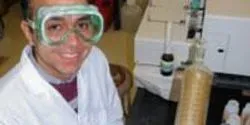News

University of Adelaide research has uncovered how the metal cadmium, which is accumulating in the food chain, causes toxicity in living cells.

Researchers at Vanderbilt University and in Germany have found that sodium –salt–accumulates in the skin and tissue in humans and mice to help control infection.

Phosphorus, a highly reactive element commonly found in match heads, tracer bullets, and fertilizers, can be turned into a stable crystalline form known as black phosphorus. In a new study, researchers from the University of Minnesota used an ultrathin black phosphorus film—only 20 layers of atoms—to demonstrate high-speed data communication on nanoscale optical circuits.

Researchers Find 3-D Printed Parts to Provide Low-Cost, Custom Alternatives for Laboratory Equipment
The 3-D printing scene, a growing favorite of do-it-yourselfers, has spread to the study of plasma physics. With a series of experiments, researchers at the Princeton Plasma Physics Laboratory have found that 3-D printers can be an important tool in laboratory environments.

















